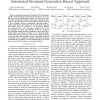Free Online Productivity Tools
i2Speak
i2Symbol
i2OCR
iTex2Img
iWeb2Print
iWeb2Shot
i2Type
iPdf2Split
iPdf2Merge
i2Bopomofo
i2Arabic
i2Style
i2Image
i2PDF
iLatex2Rtf
Sci2ools
FMCAD
2009
Springer
2009
Springer
Scalable conditional equivalence checking: An automated invariant-generation based approach
—Sequential equivalence checking (SEC) technologies, capable of demonstrating the behavioral equivalence of two designs, have grown dramatically in capacity over the past decades. The ability to efficiently identify and leverage internal equivalence points to reduce the domain of the overall SEC problem is central to SEC scalability. However, conditionally equivalent designs – within which internal equivalence may not exist under sequential observability don’t care conditions – are notoriously difficult for automated SEC tools. This paper constitutes one of the first attempts to advance the scalability of SEC for conditionally equivalent designs through automated invariant generation, which enables an inductive solution to an otherwise highlynoninductive problem. Through careful software engineering and various heuristics, this technique has been demonstrated capable of yielding orders of magnitude speedup on difficult industrial conditional SEC problems, in cases constitut...
| Added | 26 May 2010 |
| Updated | 26 May 2010 |
| Type | Conference |
| Year | 2009 |
| Where | FMCAD |
| Authors | Jason Baumgartner, Hari Mony, Michael L. Case, Jun Sawada, Karen Yorav |
Comments (0)

